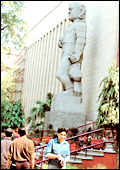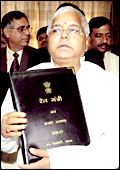 |
| RBI: Providing a rate cushion |
The
interest rate cycle is beginning to turn, taking the economy slowly
away from the low rate regime that has contributed so much to
the current consumption-led economic boom. Not surprisingly, there
are fears that the retail segment, the biggest beneficiary of
soft rates, may well be the worst loser.
Interest rates are rising because deposit
rates are rising. And that's because of stiff competition amongst
banks for, ironically, low cost deposits. The lacklustre growth
in bank deposits is quite evident from the figures put out by
the Reserve Bank of India (RBI): in January 2006 alone, deposits
grew 17 per cent year-on-year; the comparative credit growth was
32 per cent.
In fact, deposit rates have moved up from
5.25-6.5 per cent in April 2005 to 5.5-7 per cent now. Lending
rates for housing, car and personal loans have moved up marginally
from 7.5 per cent, 8.75 per cent and 12-13 per cent, respectively,
to 8 per cent, 9.50 per cent and 13-14 per cent during this period.
| FIVE DANGER SIGNALS |
»
US Fed rate at 4.5 per cent, may go higher
»
Danger of commodities-led inflation still looming large
»
Capacity expansion in every sector of the economy may result
in surplus capacity
» RBI's
move to gradually tighten prudential guidelines like a new
'securitisation guideline' is a disincentive for banks
» Depositors
moving away from banks, alter-native sources of investment
for depositors |
However, the tax relief on fixed deposits
announced in the 2006-07 Budget has put some sheen back on this
instrument and is expected to ease the competition among banks
to mobilise deposits at increasingly higher rates. Among other
reasons, stiffer provisioning norms mandated by the impending
implementation of Basel II norms (from December 2006) are also
putting pressure on the liquidity of banks and exerting upward
pressure on lending rates.
The next monetary policy, due out in April,
will provide a more precise pointer to the direction of interest
rates. Experts, however, feel the robust growth of the economy
will discourage RBI from hiking interest rates aggressively. In
the past, too, it had adopted a hands-off policy, even when the
inflation rate soared to over 6 per cent on the back of rising
global crude oil prices. So, history suggests a hands-off approach
yet again. And finally, analysts say rising income levels can
absorb the shock of at least another one per cent hike in lending
rates over a period of one year. Things will get sticky only when
housing, car and personal loan rates cross 10 per cent, 12 per
cent and 18 per cent, respectively. Till then, there is little
fear of high interest rates puncturing the boom.
-Anand Adhikari
Creating Boom II
The proposed Rail Freight Corridor will result
in huge business and job opportunities across the country.
Lalu
Prasad Yadav as an icon of economic liberalisation? No; it isn't
a bizarre joke. The Railway Minister, who is hardly anyone's idea
of an economic messiah, may still end up as one of the faces of
the great Indian growth story. But we're getting ahead of ourselves.
Let's start at the beginning: the Golden Quadrilateral and the
North-South and East West corridors kicked off the current economic
boom. And the hectic real estate activity across the country is
playing a large role in sustaining it. How? The construction industry
has linkages with more than 200 others; so, its good fortune rubs
off on them. The Railway Ministry's decision to set up a dedicated
Rail Freight Corridor promises an encore of this story.
The proposed corridor, which will cost an
estimated Rs 22,000 crore, will result in a two-fold gain for
the economy. The direct financial impact of such a massive and
pan-Indian investment will immediately result in huge job opportunities
and profits across hundreds of sectors. "And smoother movement
of freight can lead to a 30 per cent lowering of transaction costs,"
said Kapil Anand, CEO of Gateway Distriparks, one of the applicants
for the container business that has recently been thrown open
to the private sector. Implications: cheaper goods for India Inc.,
higher sales and more exports. "It will lead to tremendous
efficiency gains," agrees Urjit Patel, Executive Director,
Infrastructure Development Finance Co, "but much will depend
on issues like whether land has to be acquired afresh for the
project or whether it can be built on land already owned by the
Railways." Adds Suneet Maheshwari, Executive Director, SREI
Infrastructure Finance: "A shortage of wheel-sets for wagons,
however, may cause bottlenecks." At present, wheel-sets are
manufactured only by the Railways. A senior Railway Board official
shrugs off these concerns. "Plans to double capacity to one
lakh wheels a year have already been announced. And if the shortage
persists, the import option is always present," he says.
"It will take another year to complete
the planning, and tie up the funding. So we should be able to
start execution by April 2007," he adds. The scheduled year
of completion: 2012. When that happens, Lalu Prasad Yadav will
have shed his rustic image for good. And who knows, he might even
be the toast of Davos.
-Shalini S. Dagar
"India Needs To Be Present
At The Top Table At IMF"
Bank
of England governor Mervyn King
was in India recently to meet government officials, bankers
and industry leaders. He met Business Today's Ashish
Gupta and Shalini S. Dagar for
a freewheeling chat on the international financial system and
India's place within it. Excerpts:
What role can India play in shaping the
new financial order that is being created for the world by the
big boys of global finance?
India and China need to be present at the
top table at International Monetary Fund, which is no longer an
exclusive club of rich countries. Low- and middle-income countries
now affect the global economy. And membership of the top table
must reflect this.
There was an expectation that the euro
would emerge as an alternative to the dollar. Please comment.
It is a mistake to look at any one currency
as a benchmark for the world. The whole point of having free capital
markets is that you have several currencies co-existing at the
same time. The need for a single reserve currency is much less
than what it was earlier. One of the most encouraging developments
over the last few years has been the ability of a number of emerging
market countries to issue public debt denominated in their own
currencies. So, we are settling into a world of many currencies.
The revaluation of the Chinese yuan has
been a hotly debated topic. How do you look at the current interaction?
The discussion between China and other countries
should not be focussed exclusively on the exchange rate. Instead,
we should look at a whole range of fiscal policies. And, we must
find a proper framework in which not just China, but India, too,
should be at the table. Those private breakfast meetings on the
fringes of g-7 (Group of Seven) meetings are not enough.
So, are you recommending a revaluation
of the Indian currency as well?
No. I am not making any suggestions. All I
am saying is that we need to talk about it.
With oil prices so volatile, what is the
outlook on interest rates?
The honest answer to this is: I don't know.
What we do know are the issues that will determine the interest
rates. In our case, it is inflation. The worst thing that you
can do in economic policy is to pretend that you know. The secret
of success is to be ruthlessly honest to yourself and other people
about what you don't know.
|






